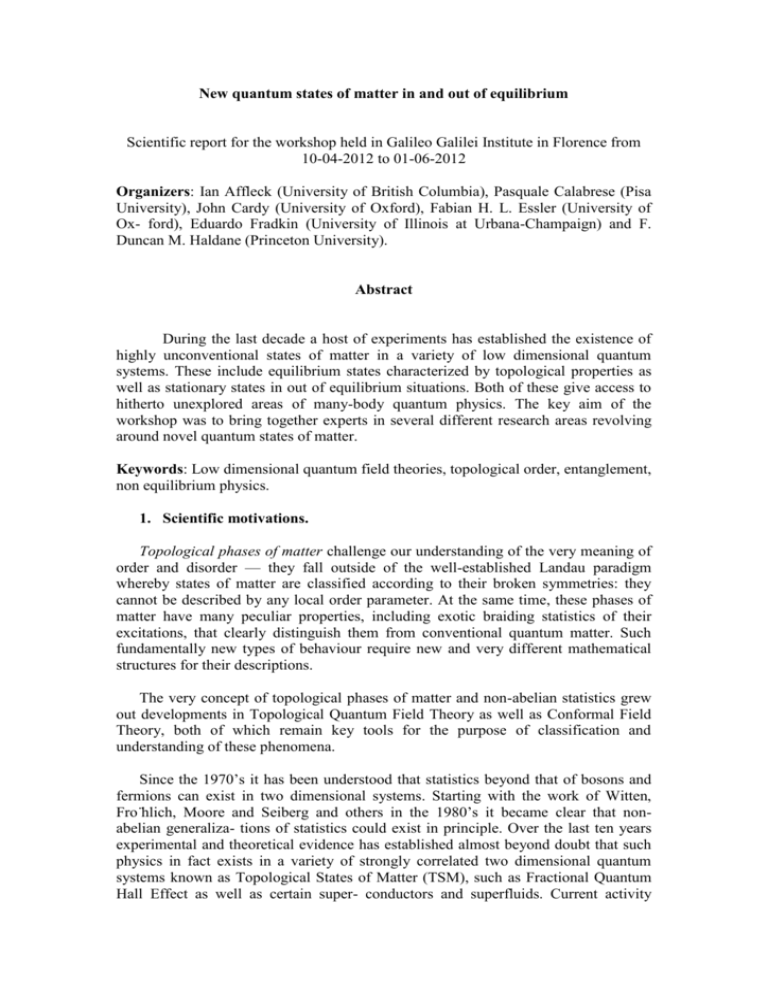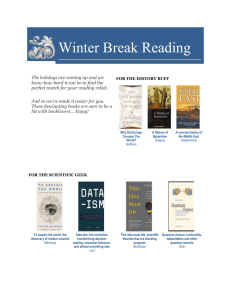New quantum - Florence Theory Group
advertisement

New quantum states of matter in and out of equilibrium Scientific report for the workshop held in Galileo Galilei Institute in Florence from 10-04-2012 to 01-06-2012 Organizers: Ian Affleck (University of British Columbia), Pasquale Calabrese (Pisa University), John Cardy (University of Oxford), Fabian H. L. Essler (University of Ox- ford), Eduardo Fradkin (University of Illinois at Urbana-Champaign) and F. Duncan M. Haldane (Princeton University). Abstract During the last decade a host of experiments has established the existence of highly unconventional states of matter in a variety of low dimensional quantum systems. These include equilibrium states characterized by topological properties as well as stationary states in out of equilibrium situations. Both of these give access to hitherto unexplored areas of many-body quantum physics. The key aim of the workshop was to bring together experts in several different research areas revolving around novel quantum states of matter. Keywords: Low dimensional quantum field theories, topological order, entanglement, non equilibrium physics. 1. Scientific motivations. Topological phases of matter challenge our understanding of the very meaning of order and disorder — they fall outside of the well-established Landau paradigm whereby states of matter are classified according to their broken symmetries: they cannot be described by any local order parameter. At the same time, these phases of matter have many peculiar properties, including exotic braiding statistics of their excitations, that clearly distinguish them from conventional quantum matter. Such fundamentally new types of behaviour require new and very different mathematical structures for their descriptions. The very concept of topological phases of matter and non-abelian statistics grew out developments in Topological Quantum Field Theory as well as Conformal Field Theory, both of which remain key tools for the purpose of classification and understanding of these phenomena. Since the 1970’s it has been understood that statistics beyond that of bosons and fermions can exist in two dimensional systems. Starting with the work of Witten, Fro ̈hlich, Moore and Seiberg and others in the 1980’s it became clear that nonabelian generaliza- tions of statistics could exist in principle. Over the last ten years experimental and theoretical evidence has established almost beyond doubt that such physics in fact exists in a variety of strongly correlated two dimensional quantum systems known as Topological States of Matter (TSM), such as Fractional Quantum Hall Effect as well as certain super- conductors and superfluids. Current activity focusses on classifying TSM’s, interpreting and designing experiments and exploring their properties. Non-equilibrium quantum systems present another area for realizing novel states of matter. Historically experimental studies of out of equilibrium evolution have been ham- pered by the effects of dissipation and decoherence, which put very restrictive limits on the time scales available for observing truly unitary time evolution. In recent years such limitations have been overcome in both cold atomic systems as well as in nanostructures. From a theoretical point of view these advances are tantalizing, because fundamental questions posed in the early days of quantum mechanics are finally amenable to experimental study. Current research focusses on two main out of equilibrium situations. In so-called quantum quenches a closed system evolves unitarily from an initial state that is not a Hamiltonian eigenstate. This can be achieved e.g. by suddenly switching a control parameter such as a magnetic field. An important question under investigation is under what conditions the system reaches a stationary state characterized by an effective “thermal” i.e. equilibrium distribution. Manifestly non-equilibrium stationary states can be realized in driven systems, where e.g. quantum wires are kept out of equilibrium by driving a current through them through application of an external bias voltage. A main focus in this setting has been the determination of the distribution function of current fluctuations. For many of the low dimensional quantum systems of interest for experimental studies, the equilibrium physics is well described by field theory methods based e.g. on conformal invariance and integrability. However, how to manipulate these field theories in out of equilibrium situations beyond perturbation theory (Keldysh formalism) is known only for a few examples. Furthermore it is not a priori clear to what extent and in which regimes field theory correctly describes the particular quantum system of interest. In this respect the recent experimental achievements provide a unique opportunity to develop and test new ideas for out of equilibrium field theories. 2. The workshop and some scientific outcomes. The workshop lasted for a total of 7 weeks (excluding the conference which will be described separately). During this period more than 100 scientists from different physics institutions worldwide discussed and collaborated on the topics of the workshop. The full list of participants is reported on the workshop website. More than 30 participants per week were present in the institute at all time. During this period a morning talk took place almost every day, and on occasion more informal and technical afternoon sessions were organized in addition. Throughout the workshop we took advantage of the proximity to one of the world leading experimental groups in the physics of cold atomic gases at University of Florence and LENS. We organized several seminars by members of this laboratory, which generated lively and fruitful discussions between theorists and experimentalists and, we hope, will lead to several collaborations. To give some specific examples, Prof. N. Cooper (University of Cambridge) reported on new results on topological bandstructures in ultracold atoms, which were of great interest to the experimental group, while Dr. N. Fabbri (LENS Florence) reported on the measurement of dynamical correlation functions in 1D Bose gases, which were previously calculated by several partic- ipants of the workshop. A complete list of seminars is available on the workshop website. Some of the seminars, that generated particularly lively discussions are (a) Ehud Altman, Real space RG for dynamics of random spin chains and many-body localization, (b) German Sierra, Quantum spin models in one and two dimensions from the WZW model, (c) J. Dubail, Topological phases of matter: from bulk model wave functions to the edge theory; (d) K. Schoutens, Non-Abelian spin textures, (e) Ady Stern, From fractionalized topological insulators to fractionalized Majoranas, (f) Ian Affleck, Magnetism on the edges of graphene ribbons. The programme provided a unique environment for starting, consolidating and extending collaborations. A preliminary list of manuscripts acknowledging the GGI (22 up to the date) is available on the website. They include 1. Two manuscripts on quantum quenches in the transverse field Ising chain by P. Calabrese, F.H.L. Essler, and M. Fagotti (all participants to the workshop). 2. “Designing Topological Bands in Reciprocal Space” by N. R. Cooper and R. Moess- ner (both participants). 3. A systematic approach to the entanglement negativity has been partially developed in Florence by P. Calabrese, J. Cardy, and E. Tonni (again all participants to the workshop). 4. A new collaboration started in Florence led to the work on “Corner contribution to percolation cluster numbers” by J. Cardy and F. Igloi. 3. The conference. 4. During the week of May 21-25 a conference bringing together leading theorists and experimentalists working on new quantum states of matter took place. There were a total of 40 talks (8 per day). The conference was structured around the various themes covered by the programme. In the following we list the themes and two representative talks per theme (the full list of talks can be found on the workshop webpage). Topological states of matter. I. Cirac (Max Planck, Munich) An order parameter for symmetry-protected phases in one dimension. F.D.M. Haldane, (Princeton) Quantum geometrodynamics of the fractional quantum Hall effect. New results on cold atomic gases in equilibrium. H.C. Naegerl (Innsbruck) Atoms with tunable interactions in 1D and 3D optical lattice confinement. M. K ̈ohl (Cambridge) 2D Fermi gases. Cold atomic systems out of equilibrium. I. Bloch (Max Planck, Munich) From quantum magnetism to quantum quenches: probing non-equilibrium dynamics with ultracold atoms. E. Demler (Harvard) Ramsey interference as a probe of many-body dynamics. Non equilibrium dynamics in isolated quantum systems. J. Cardy (Oxford) Quantum quenches in perturbed conformal field theories. P. Wiegmann (Chicago), On the theory of edge states: Fractionally charged solitons on the edge and conformal invariance of FQHE states. Quantum Transport. D. Bernard (ENS Paris) Non-equilibrium CFT. L. Glazman (Yale) Inelastic electron backscattering in a generic helical hedge. Entanglement in many body systems. F. Verstraete (Vienna) Continuous matrix product states and entanglement in continuous quantum many-body systems. G. Vidal (Perimeter institute) A real space decoupling transformation for quantum many-body systems. Strongly correlated electron systems and Quantum phase transitions. E. Fradkin (Urbana) The stability of the Quantum Lifshitz Model. D.A. Tennant (Berlin) Thermal and exotic quantum states in magnets. A report on the workshop would not be complete without remembering a key participant, Prof. Adilet Imambekov of Rice University. Adilet tragically passed away on July 18, 2012 on Khan Tengri mountain in Kyrgyzstan at the age of 30. Adilet was a bright young star with many impressive contributions to the field and will be dearly missed by all who knew him.






